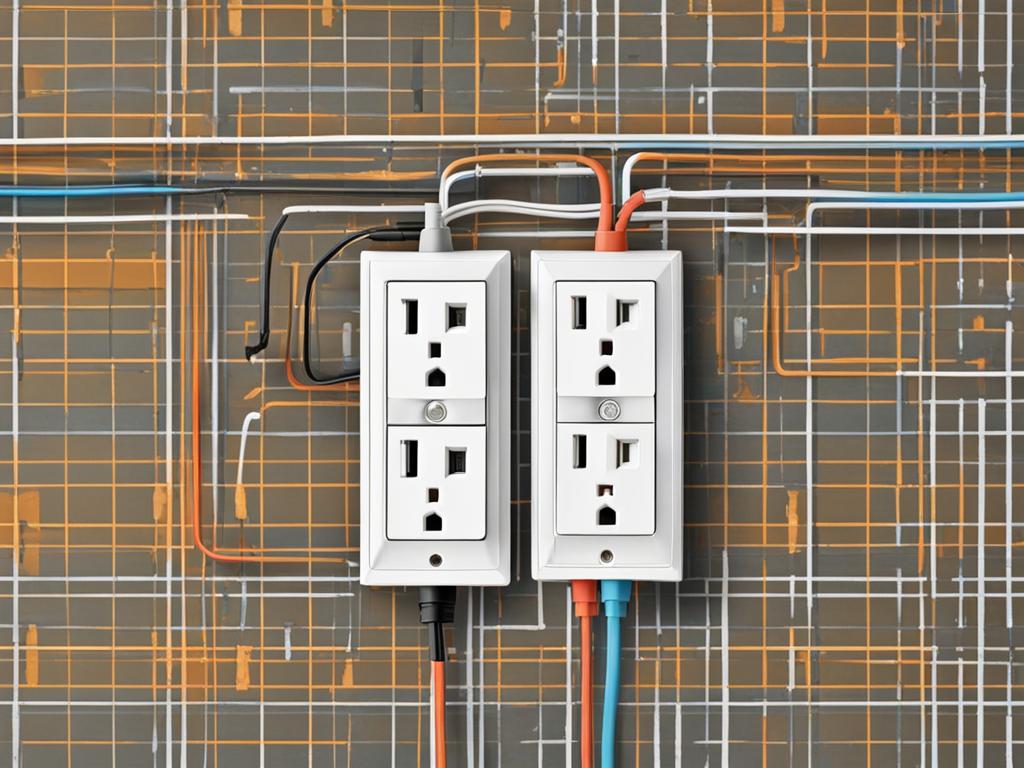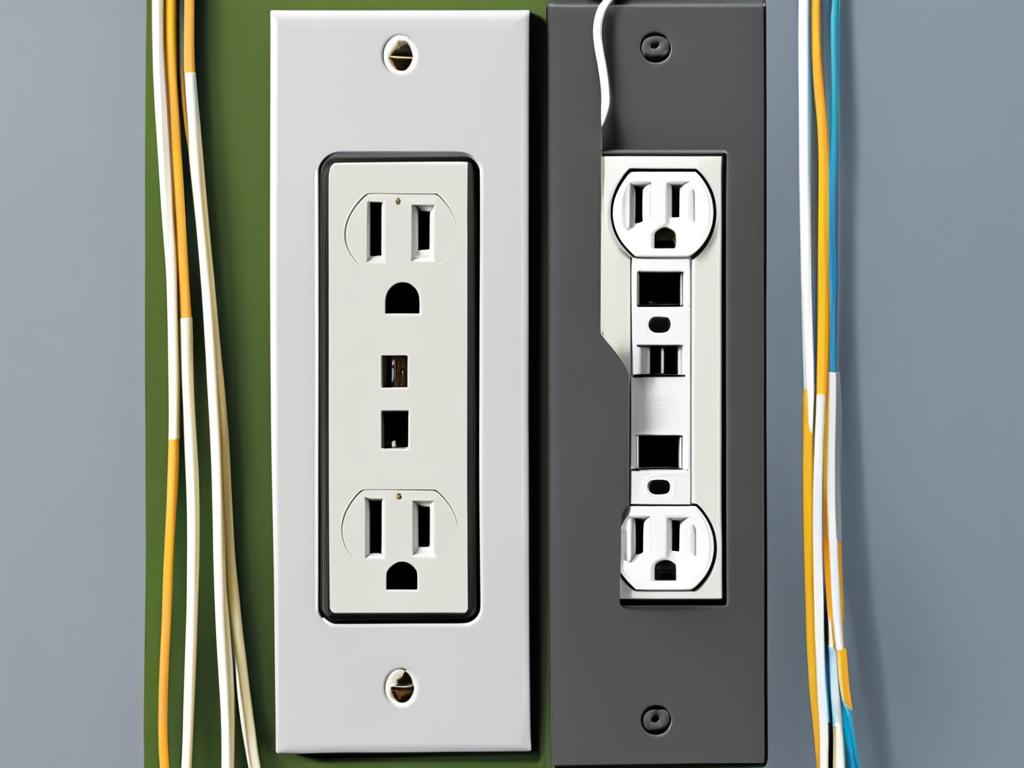Welcome to our article on pigtail vs daisy chain outlets! When it comes to electrical outlets, choosing the right wiring option is crucial for ensuring both safety and efficiency. In this guide, we’ll take a closer look at the differences between pigtail and daisy chain wiring methods, and highlight the best practices to follow. So, let’s dive in!
Key Takeaways:
- Pigtail wiring is generally recommended for its superior safety and effectiveness in home applications.
- Pigtailing allows outlets to run in parallel, while daisy chaining connects outlets in series.
- Daisy chaining carries a higher risk of overloading and causes all downstream outlets to fail if one outlet fails.
- Pigtail wiring can be more complex and time-consuming when dealing with multiple circuit wires.
- Following electrical codes and best practices can optimize the efficiency and safety of your home wiring.
The Key Differences Between Pigtail and Daisy Chain Connections
When it comes to electrical connections, understanding the differences between pigtail and daisy chain wiring is crucial. These wiring methods have distinct configurations and properties that can impact electrical safety and efficiency. Let’s explore the key contrasts between pigtail and daisy chain connections.
Pigtail Connections: Parallel Wiring
In pigtail connections, the incoming and outgoing wires are joined together using a short jumper wire, which is then connected to the outlet. This arrangement creates a parallel wiring configuration. In other words, each outlet is connected separately to the source of power. If one outlet fails, the others can continue functioning independently.
This parallel wiring of pigtail connections offers several advantages. Firstly, it provides better reliability as the individual outlets are not dependent on each other. Additionally, it allows for the division of current flow among the connected devices, preventing overloading and ensuring the steady operation of each outlet.
Here’s an example of how pigtail wiring is typically set up:
| Incoming Wire | Outgoing Wire | Jumper Wire | Outlet |
|---|---|---|---|
| Hot | Hot | Jumper | Outlet 1 |
| Neutral | Neutral | Jumper | Outlet 1 |
| Ground | Ground | Jumper | Outlet 1 |
Daisy Chain Connections: Series Wiring
On the other hand, daisy chain connections involve connecting the incoming and outgoing wires directly to the terminals on each outlet, creating a series wiring configuration. In this setup, the outlets are daisy chained together, with the power flowing from one outlet to the next.
While daisy chain connections may seem simpler to set up, they come with inherent risks. If one outlet in the series fails, either due to a fault or overloading, the remaining outlets downstream will lose power. This can potentially lead to inconvenience and the need to troubleshoot multiple outlets if a problem occurs.
Here’s an example of how daisy chain wiring is commonly implemented:
| Incoming Wire | Outlet | Outlet | Outlet |
|---|---|---|---|
| Hot | Outlet 1 | Outlet 2 | Outlet 3 |
| Neutral | Outlet 1 | Outlet 2 | Outlet 3 |
| Ground | Outlet 1 | Outlet 2 | Outlet 3 |
As depicted in the examples, pigtail and daisy chain connections have different electrical properties and implications. The decision of which wiring method to choose depends on various factors, such as the specific electrical requirements and safety considerations of the installation.

What is Pigtail Wiring?
Pigtail wiring is a method where several wires are connected together to attach to a single connection. It is a commonly used technique in electrical installations to reduce the number of wires and extend the length of wire to suit the connected device’s requirements. Pigtailing offers numerous benefits in terms of electrical efficiency and safety.
One of the primary advantages of pigtail wiring is that it prevents problems downstream in the circuit. With pigtail wiring, if one outlet has a fault or fails, the rest of the circuit can continue to work seamlessly. This ensures that electrical appliances and devices connected to other outlets on the same circuit remain operational.
Furthermore, pigtail wiring simplifies the wiring in the receptacle box. Instead of multiple wires running directly to the outlet, a single hot, neutral, and ground wire is connected to allow connection to the outlet. This streamlined wiring configuration reduces potential confusion and clutter in the electrical box, making it easier to identify and troubleshoot any issues that may arise in the future.
When it comes to troubleshooting, pigtail wiring also offers advantages. Since each outlet is wired individually, it is easier to isolate and identify problems should they occur. This targeted approach saves time and effort in diagnosing and resolving electrical issues, allowing for a quicker and more efficient troubleshooting process.
Overall, pigtail wiring provides improved electrical safety, efficient circuit functionality, and simplified troubleshooting capabilities. By incorporating pigtail connections into your electrical installations, you can enhance the reliability and performance of your electrical systems while ensuring the safety of your home or building.
| Pigtail Wiring Benefits | Pigtail Wiring Considerations |
|---|---|
| Enhanced electrical safety | Potential complexity and time-consuming |
| Prevents problems downstream in the circuit | Requires proper wire connections and insulation |
| Simplified wiring in the receptacle box | Appropriate wire gauge selection is crucial |
| Easier troubleshooting and fault isolation | Accurate labeling of wires is important for future reference |
Why Are Pigtail Connections Recommended?
Pigtail connections are highly recommended when it comes to electrical safety and efficiency. They offer several advantages over other wiring methods, making them the preferred choice for many electricians and homeowners.
From an electrical safety standpoint, pigtail connections provide an added layer of protection for your electrical circuit. By using pigtails, any problems or faults that occur in one outlet will not affect the rest of the circuit. This ensures that your electrical system remains stable and minimizes the risk of electrical issues propagating throughout your home.
In addition to safety benefits, pigtail wiring also simplifies the wiring process. Instead of having multiple wires connected directly to the outlet terminals, a single hot, neutral, and ground wire is used. This streamlined configuration reduces the chances of wiring mistakes and makes it easier to mount the outlet properly.
From a user standpoint, pigtail connections make troubleshooting and fixing outlet issues much simpler. Since each outlet is individually wired, it becomes easier to isolate and identify problems if they arise. This saves time and effort in diagnosing and resolving any electrical issues that may occur within the outlet.
Furthermore, pigtail connections ensure circuit continuity even if one outlet were to fail. The parallel wiring configuration allows the remaining outlets to continue functioning properly, providing uninterrupted power supply to your electrical devices.
Expert Tip:
Pigtailing is especially useful when dealing with GFCI (Ground Fault Circuit Interrupter) outlets. The pigtail connection allows the GFCI to continue functioning even if other outlets on the same circuit fail. This ensures that the GFCI can still provide electrical safety protection, such as detecting ground faults and preventing electrical shocks.
Overall, pigtail connections offer significant advantages from both an electrical safety perspective and a user standpoint. Their ability to prevent circuit issues from spreading, simplify wiring, aid in troubleshooting, and ensure circuit continuity make them the recommended choice for mounting outlets.

Conclusion
In conclusion, when it comes to connecting electrical outlets, following best practices such as pigtail wiring is crucial for both electrical efficiency and safety. Compared to daisy chaining, pigtail wiring offers a more reliable solution for your home wiring needs.
While daisy chaining may be easier to set up, it poses potential risks. Daisy chains have a higher risk of overloading the circuit breaker, which can lead to power interruptions and affect multiple outlets if one fails. On the other hand, pigtailing allows for parallel wiring, ensuring that even if one outlet experiences a fault, the rest will continue to function properly.
By embracing pigtail wiring and adhering to electrical codes, you can optimize the efficiency and safety of your home wiring practices. Not only does pigtail wiring provide better protection against electrical hazards, but it also simplifies troubleshooting and ensures circuit continuity for uninterrupted power supply. Prioritizing electrical safety and using pigtail connections serves as the best practice for reliable and efficient electrical outlet installations.
FAQ
What is the difference between pigtail and daisy chain outlets?
Pigtail wiring involves connecting multiple wires together to attach to a single connection, while daisy chaining connects outlets in series. Pigtail wiring allows outlets to run in parallel, ensuring that if one outlet fails, the others can continue working. In contrast, daisy chaining connects outlets in series, causing all downstream outlets to lose power if one fails.
Why are pigtail connections recommended?
Pigtail connections are recommended for their electrical safety and efficiency. They prevent problems from affecting the rest of the circuit, simplify the wiring in the receptacle box, and ensure the rest of the circuit continues to function if one outlet has a fault. Pigtailing also makes it easier to troubleshoot and fix issues with the outlet and ensures circuit continuity.
What is pigtail wiring?
Pigtail wiring is a method where several wires are connected together to attach to a single connection. It is commonly used to reduce the number of wires and extend the length of wire to suit the connected device. Pigtailing offers benefits in terms of electrical safety and efficiency, as it prevents problems downstream in the circuit, simplifies the wiring in the receptacle box, and ensures the rest of the circuit continues to work if one outlet has a fault. Troubleshooting problems in the future is also easier with pigtail wiring.
What are the benefits of pigtail connections?
Pigtail connections offer several benefits. They enhance electrical safety by preventing problems from affecting the rest of the circuit. For users, pigtailing simplifies the wiring in the receptacle box, making it easier to troubleshoot and fix issues with the outlet. Additionally, pigtail connections help in mounting the outlet correctly and ensure circuit continuity if one outlet fails.
